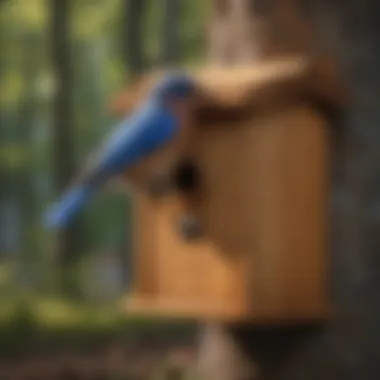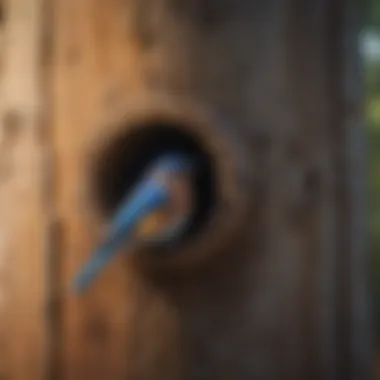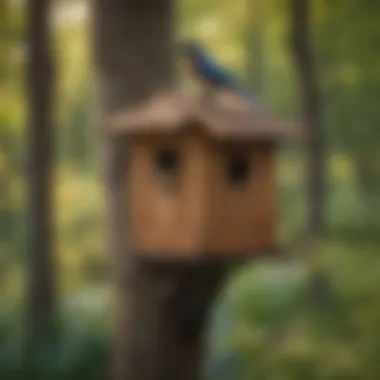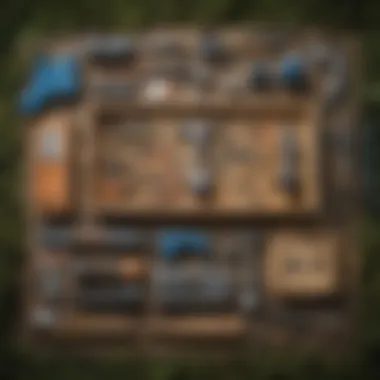Building a Bluebird Box: A Practical Guide


Intro
Constructing a bluebird box is more than a simple woodworking project. It serves as an important contribution to wildlife conservation, particularly for the bluebird population. This guide aims to equip enthusiasts with practical information on materials, techniques, and considerations involved in creating a functional nesting box for these beautiful birds. With the right practices, building a bluebird box provides not only a home for the birds but also facilitates observation of their behaviors and nesting habits.
Overview of Bluebirds
Bluebirds are small, vibrant birds often associated with open habitats, such as fields and orchards. They are a vital part of the ecosystem, helping with insect control and contributing to seed dispersal. As habitats shrink and predators increase, building nesting boxes has become increasingly important for their survival. By providing nesting sites, individuals can support bluebird populations and gain valuable insights into their ecological roles.
Materials Needed
When preparing to build a bluebird box, it is essential to choose the right materials. Common options include:
- Wood: Untreated cedar or pine is ideal due to its durability.
- Screws: Use exterior screws to ensure longevity.
- Hinges: These will assist in access for cleaning.
- Non-toxic paint: If desired, opt for a water-based, non-toxic finish.
Selecting materials carefully not only contributes to the success of the box but also prevents harmful effects on the wildlife.
Construction Techniques
Building the box involves specific techniques to ensure it meets the needs of bluebirds. Here is a basic outline of the construction process:
- Design: A standard bluebird box usually measures around 6" x 6" for the base and 10" tall.
- Cutting: Cut the wood pieces to the desired dimensions using a saw. Ensure edges are smooth for safety.
- Assembly: Attach the sides to the base using screws. The front should be removable for easy access.
- Entrance Hole: Create a hole that is approximately 1.5" in diameter—this is optimal for bluebirds.
- Ventilation: Drill holes near the top sides for airflow.
- Finishing Touches: Sand down any rough edges and treat with a non-toxic finish if desired.
Placement and Maintenance
The success of a bluebird box largely depends on its placement. Consider these key factors:
- Location: Install the box in a sunny area, away from heavy vegetation.
- Height: Place it 4 to 6 feet off the ground on a pole or tree, ensuring it stands out to the birds.
- Monitoring: Check the box regularly during the nesting season, but do so with caution to minimize disturbance.
After the nesting concludes, clean out old nesting material to prepare for the next season. Regular maintenance ensures the longevity of the box and supports continual use by bluebirds.
"Creating a bluebird box is a rewarding task that directly supports the conservation of these elegant creatures."
Building a bluebird box is a practical step toward understanding and preserving a significant part of our ecosystem. With the right materials, construction techniques, and maintenance practices, anyone can contribute to the flourishing of bluebird populations. Whether you’re a homeowner desiring a slice of nature or an educator wishing to teach about wildlife, this project offers enrichment and joy.
Prolusion to Bluebird Boxes
The construction of bluebird boxes has significant implications for both conservation efforts and the enjoyment of nature. Bluebirds, particularly the Eastern Bluebird, have experienced population declines due to habitat loss and competition for nesting sites. Providing artificial nesting boxes is a practical way to help these birds thrive in areas where natural cavities are scarce. Building a bluebird box is not just about creating a shelter; it’s a commitment to fostering a healthy ecosystem and supporting bird conservation initiatives.
Understanding Bluebirds
Bluebirds are small, migratory birds known for their vibrant blue plumage and melodious songs. They primarily feed on insects and fruits, making them valuable for pest control and seed dispersal. Understanding their behavior and preferences can greatly enhance the placement and design of nesting boxes. Bluebirds prefer open areas with nearby trees or shrubs, which provide perches for hunting. Their attraction to these habitats means that constructing boxes in suitable locations can significantly increase the chance of occupancy.
Importance of Nesting Boxes
Nesting boxes serve multiple purposes. First, they provide a safe environment for bluebirds to raise their young. Natural nesting sites have decreased because of urbanization and farming practices. Second, artificial boxes can help deter invasive species, such as House Sparrows, that compete for nesting sites. By constructing and placing bluebird boxes correctly, enthusiasts can aid in the species' recovery and contribute to biodiversity. Thus, fostering an understanding of their advantages is crucial for those engaged in conservation efforts.
Materials Required for Construction


Understanding the materials necessary for constructing a bluebird box is critical. The choice of materials significantly impacts the effectiveness and longevity of the box. Well-selected materials ensure that the box can withstand various weather conditions while providing adequate protection for the bluebirds. Additionally, using the right components can enhance the overall usability and maintenance of the nesting box.
Wood Selection
Types of Wood Suitable for Bluebird Boxes
When selecting wood for bluebird boxes, it is essential to consider durability, safety, and suitability for the bluebirds. Common wood types used include cedar, pine, and plywood. Cedar is particularly favored because it resists warping and is naturally resistant to rot and insects. Its lightweight property is advantageous, making it easier to manage during construction. Pine, on the other hand, is readily accessible and cost-effective. However, it should be untreated to avoid harmful chemicals that could affect the birds. Plywood can also be a suitable option, yet it may lack the durability found in solid wood options.
Using the right type of wood contributes to the overall integrity of the box, allowing it to provide a safe nesting environment.
Advantages of Untreated Wood
Opting for untreated wood brings multiple benefits that directly enhance the purpose of the bluebird box. One of the main advantages is the absence of harmful chemicals that could compromise the health of the nesting birds. Untreated wood allows the natural scent and texture, which can provide a comfortable environment for bluebirds. Additionally, untreated wood may be more suitable for environmental sustainability since it does not contribute to chemical leaching into the soil.
Yet, untreated wood can be more susceptible to decay. It is essential to regularly monitor the integrity of the box, especially in humid climates. Overall, untreated wood offers a balanced approach for bluebird boxes, aligning with conservation efforts while still providing essential structural support.
Additional Materials
Nails and Screws Considerations
Choosing the right fasteners is vital for the durability of the bluebird box. For construction, galvanized screws or nails are widely recommended due to their corrosion resistance. These options extend the lifespan of the box, particularly in outdoor conditions where moisture is prevalent. Avoid using regular nails as they may rust over time, leading to structural failure.
Using screws can also offer a significant advantage in assembly, allowing for easier dismantling when maintenance or cleaning is necessary. While nails may secure wood together effectively, screws establish a firmer grip on the materials, enhancing overall stability.
Finishing Products and Their Use
Finishing products such as non-toxic wood sealers, paints, and stains can play a role in protecting the bluebird box. However, it is crucial to ensure that any finishing product is free from harmful chemicals. Applying a water-based sealer can extend the life of the wood by protecting it from moisture damage and UV rays.
Despite these benefits, excessive use of finishes could deter bluebirds, as the scents may be unappealing. A balanced approach with minimal and safe finishes ensures the bluebird box remains attractive to its intended inhabitants while also maintaining structural integrity.
Design Specifications
Design specifications are critical when it comes to building bluebird boxes. The dimensions, ventilation, drainage, and entrance hole requirements play significant roles in ensuring the success of these nesting structures. Proper adherence to design specifications not only enhances the chances of attracting bluebirds but also helps to minimize potential issues that could arise during the nesting period. Understanding these elements can make all the difference in fostering a suitable environment for bluebirds and promoting their overall conservation.
Dimensions of a Bluebird Box
The dimensions of a bluebird box are not arbitrary. They are specifically formulated to cater to the needs of bluebirds while discouraging potential predators or unwanted species from invading the nesting area. The ideal internal dimensions for a bluebird box are approximately seven inches wide, five inches deep, and ten inches tall. This size creates enough room for bluebird chicks to grow, while still being snug enough to provide a sense of security.
External dimensions should be slightly larger to accommodate the walls and any potential adornments. A general recommendation for the exterior is around eight by six by 12 inches. Additionally, when constructing the box, it is important to ensure that the walls are thick enough, ideally three-quarters of an inch, to withstand harsh weather conditions without warping or compromising the structure.
Ventilation and Drainage
Ventilation and drainage are essential aspects of bluebird box design. Proper ventilation prevents overheating during warmer months, which can be detrimental to the health of the eggs and the fledglings. To facilitate airflow, small holes can be drilled into the upper part of the box. A ventilation gap of about two inches from the top ensures a good flow of fresh air.
Drainage, on the other hand, helps to keep the interior dry during rain or high humidity. Installing small drainage holes near the bottom of the sides can effectively prevent water from accumulating inside the box. These holes should be around one-quarter inch in diameter. Blocking the exit for larger intruders while allowing water to escape is key to maintaining a conducive environment inside the box.
Entrance Hole Requirements
The entrance hole is a pivotal feature of a bluebird box that determines accessibility for bluebirds while deterring larger birds and predators. The ideal diameter for the entrance hole is one and a half inches. This size is perfect for Eastern Bluebirds, the most common species that utilize these boxes. For other types, such as Western Bluebirds, slightly larger holes may be required.


The height of the entrance hole should be positioned approximately six inches from the floor of the nesting box. This placement allows for sufficient space for the nest and the young birds to develop without the risk of falling out. Also, when deciding on the location of the entrance, ensure it faces away from prevailing winds to reduce weather-related disturbances.
Proper design specifications enhance the likelihood of bluebird nesting success and contribute to ongoing conservation efforts.
In summary, attention to design specifications greatly influences the effectiveness and longevity of bluebird boxes. Ensuring the right dimensions, incorporating proper ventilation and drainage, and carefully considering entrance hole requirements are crucial steps toward creating a functional and safe environment for bluebirds.
Construction Techniques
When constructing a bluebird box, the methods used are critical to the final result. The success of the nesting box relies heavily on precision and an understanding of construction techniques. By employing the right methods, you ensure that the box will meet the needs of bluebirds while being durable enough to withstand the elements. Proper construction not only enhances the functionality of the bluebird box but also increases the likelihood of attracting these birds to your yard.
In this section, we will delve into the step-by-step process of assembling the box and discuss common pitfalls to avoid. Each aspect of the construction process is important, as any oversight can lead to unfavorable conditions for both the birds and the structure itself.
Step-by-Step Guide to Assembly
Assembling a bluebird box can be a straightforward task if you follow a structured process. Below is a concise guide:
- Prepare Your Materials: Make sure you have all necessary materials at hand and your tools ready.
- Cut the Wood: Measure and cut the wood according to the specifications detailed in the design section. Precision in cutting ensures a snug fit.
- Create the Entrance Hole: Drill the entrance hole at the specified location. The diameter is crucial as it determines which birds can enter.
- Assemble the Walls: Start by attaching the walls together using nails or screws. Ensure they are aligned properly to avoid gaps.
- Install the Roof: Fix the roof in place with a slight overhang to protect against rain. It provides essential shelter for the nesting birds.
- Add Ventilation and Drainage Holes: These features are essential for maintaining a suitable environment inside the box. Make sure they are adequately placed.
- Finishing Touches: Sand any rough edges and if desired, treat the wood with a safe, non-toxic sealant for additional protection. Avoid using paint or stain that could be harmful to birds.
Following these steps will lead to a well-constructed bluebird box that is functional and appealing.
Common Mistakes to Avoid
During construction, several common mistakes can hinder the effectiveness of your bluebird box. Awareness of these issues is key to successful building:
- Improper Ventilation: Failing to include ventilation holes can create an overly hot environment inside the box, which is detrimental to the eggs and chicks.
- Wrong Entrance Hole Size: An entrance hole that is too large may allow predators access, while one that is too small can deter bluebirds altogether.
- Using Treated Wood: Using treated wood can be harmful. Chemicals used in treatment can pose risks to bluebirds, so opting for untreated wood is preferred.
- Poor Structural Integrity: Neglecting to align walls and roofs correctly can result in a box that is unstable and prone to damage.
Remember: A bluebird box is only as effective as its construction. Take the time to ensure your choices lead to a safe haven for nesting.
By implementing sound construction techniques and avoiding common pitfalls, you can significantly increase the chances that your bluebird box will attract and successfully nurture bluebirds.
Placement of Bluebird Boxes
The placement of bluebird boxes is crucial for attracting these birds and ensuring their successful nesting. Selecting the right location significantly impacts the birds’ willingness to use the box. When done properly, it can enhance the chances of bluebird survival and reproduction. Understanding key elements such as optimal locations, height considerations, and proximity to natural resources will provide important benefits in the overall success of bluebird conservation efforts.
Optimal Locations
Choosing the right location for a bluebird box should consider several factors. Ideal spots generally include open fields, meadows, or areas with low vegetation. Bluebirds prefer places where they can easily spot predators while ensuring access to food sources. Here are some important considerations when selecting a location:
- Visibility: Boxes should be placed in areas with clear sightlines to help bluebirds identify potential dangers quickly.
- Sunlight: Ensure that the box receives adequate sunlight to warm the interior during colder periods, reducing the risk of hypothermia for hatchlings.
- Avoid Dense Forests: Bluebirds typically do not nest within thick woods, as these areas provide concealment for predators.
Height Considerations
The height of the bluebird box is another critical factor to consider. While there is some flexibility, the commonly recommended height is about five to six feet off the ground. This height helps the box remain out of reach of ground predators. Furthermore, it facilitates easier monitoring and maintenance. Here are some tips related to height placement:
- Adjust Based on Habitat: In open areas, slightly higher placements can help, while in bushy areas, lower placements might be more suitable.
- Ensure Stability: It is essential for the box to be securely mounted to avoid swaying or falling, which could deter bluebirds from nesting.
Proximity to Natural Resources


Bluebirds thrive in environments where they have easy access to food and water sources. The best locations for bluebird boxes are near open spaces with insects, berries, and other food resources. Here are some considerations related to this proximity:
- Insect Abundance: Bluebirds predominantly feed on insects. Placing the box near areas with abundant insect life is beneficial, particularly during breeding season.
- Water Sources: Being close to water bodies like ponds or streams can also enhance the attractiveness of the site. Water plays a vital role in keeping the birds hydrated and aids in foraging.
- Avoid Human Disturbance: Ensure that the placement does not interfere with regular human activities, minimizing disturbance to the nesting birds.
Proper placement of bluebird boxes not only fosters a safe nesting environment but also encourages attraction to the boxes. The interaction of appropriate location, adequate height, and access to resources serves as a foundation for successful bluebird nesting.
Maintenance and Monitoring
Maintenance and monitoring are critical for ensuring the long-term viability of bluebird boxes. Just as the construction of these nesting sites is crucial, their upkeep plays a significant role in attracting and supporting bluebird populations. Regular maintenance helps to maintain a clean and safe environment for the birds, while thoughtful monitoring can provide insights into their nesting behavior and overall health.
By performing routine checks, you can detect potential issues before they become serious problems. For instance, accumulated debris or parasite infestations can lead to lower nesting success rates. Additionally, monitoring activities allow enthusiasts and professionals alike to appreciate the growth and changes in bluebird populations within their area.
Cleaning Procedures
Cleaning the bluebird box is essential, particularly at the end of the nesting season. The removal of old nesting materials not only prepares the box for new occupants but also reduces the likelihood of diseases spreading among chicks. Here are some practical tips for effective cleaning:
- Wait for the Right Moment: Clean the bluebird box when you are certain it’s unoccupied. This often means waiting until late summer or early fall, after fledging has occurred.
- Gather Your Supplies: Use gloves, a brush, and a mild disinfectant solution. It’s important to avoid harsh chemicals that could harm the birds.
- Remove Old Materials: Carefully take out any leaves, twigs, or other nesting materials. Place them in a bag for proper disposal.
- Brush and Disinfect: Using a brush, scrub the interior surfaces of the box. Then, apply the disinfectant solution and let it dry thoroughly before reassembling the box.
By following these steps, you contribute to a healthier environment for future bluebird families.
Monitoring Bluebird Activity
Monitoring bluebird activity not only aids in the conservation efforts but also enhances your understanding of these birds. Observing their behavior gives valuable insight into their nesting habits and survival challenges. Here are some effective ways to monitor:
- Record Keeping: Maintain a log of nesting activity within bluebird boxes. Note dates of egg laying, hatching, and fledging. This data helps in recognizing patterns over time.
- Behavior Observation: Pay attention to if and how often bluebirds visit the box. Frequent visits may indicate successful nesting, while a lack of activity could signal problems.
- Join Community Groups: Engaging with organizations focused on bluebird conservation will provide support and valuable data-sharing opportunities.
Regular monitoring fosters a deeper connection to the bluebirds nesting in your box and promotes ongoing efforts for their conservation.
Acting on found information can support better practices in manufacturing bluebird boxes and enhance survival rates in the greater environment.
Finale
The conclusion serves as a vital component of this practical guide, summarizing the key aspects of constructing bluebird boxes and their significance. Understanding the importance of bluebird conservation and the roles these boxes play helps reinforce the motivation behind your efforts. By providing safe nesting habitats, individuals can directly impact bluebird populations, which face various threats in their natural environments.
Recap of Key Points
In this guide, we explored several critical aspects of building a bluebird box:
- Understanding Bluebirds: Knowing the behavior and habitat preferences of bluebirds is essential for success.
- Materials: Selecting appropriate untreated wood and other materials ensures the longevity and safety of the box.
- Design Specifications: Adhering to specific dimensions, ventilation, and entrance hole requirements is crucial for attracting bluebirds.
- Construction Techniques: Detailed step-by-step guidance aids in avoiding common construction pitfalls.
- Placement: Understanding optimal locations, height considerations, and proximity to natural resources maximizes the box's effectiveness.
- Maintenance: Regular cleaning and monitoring ensure that the nesting boxes remain functional and safe.
The culmination of these elements leads to a well-constructed bluebird box that supports local wildlife and contributes to conservation efforts.
Future Considerations for Bluebird Conservation
As we look ahead, consideration for bluebird conservation must expand beyond individual box construction. Here are a few aspects to contemplate:
- Habitat Preservation: Advocacy for preserving natural habitats for bluebirds is essential. Efforts should be made to protect existing environments where bluebirds can thrive.
- Community Involvement: Engaging local communities in conservation initiatives can create awareness and shared responsibility for bluebird populations.
- Research and Monitoring: Continuous research into bluebird behaviors and populations assists in refining best practices for nesting box construction and placement.
- Legislative Action: Supporting policies that protect bluebird habitats and promoting regulations against habitat destruction can make a significant positive impact.
By integrating these considerations, the involvement in bluebird conservation can broaden, leading to sustainable results that benefit bluebird populations for generations to come.
"Every small effort counts, and collectively they nourish the ecosystem that bluebirds rely on."
For more insights into bluebird conservation, visit Wikipedia or connect with local groups on Reddit and Facebook.
Engagement in bluebird conservation, driven by informed practices, ensures a brighter future for these beautiful birds.















